Ganesh Chaturthi is one of the grandest celebrations in India. Every year, the 10-day festival is celebrated with pomp & splendor, as devotees decorate their homes, welcome statues of Ganesha, and immerse themselves in prayer and devotion. This year, Ganesh Chaturthi will be celebrated on August 27th, during the Shukla Paksha Chaturthi of Bhadrapada month. The festival will last 10-11 days, concluding with Ganesh Visarjan on September 6th.
But let’s talk more about the Ganesha statues themselves. Did you know that each statue has numerous symbolisms? For example, do you know what his trunk symbolizes when it’s on the right side, and what it means when it’s to the left? Did you know that even though the statues all look the same, there are subtle differences that mean different things? If you didn’t, then this blog has everything you need to know before purchasing a Ganesha statue.
Oh, and before we forget. If you want to do some festival shopping, here are some Ganesh Chaturthi offers you can check out to make the celebration even more special.
Let’s start by looking at the history of Lord Ganesha and how Ganesh Chaturthi came into being. This will help you better understand the festival and pick the right statue for your ritual.
Who Is Ganesh?
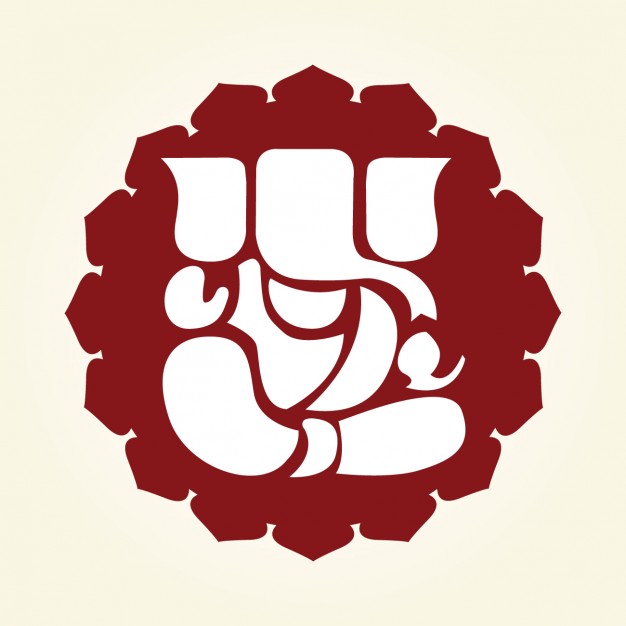
If you are unfamiliar with the Hindu philosophy, then let us explain it this way. If Hindu Gods were a cricket team, then Ganesha would be the captain of that cricket team. With the head of an elephant, and a mouse as his vehicle, he is known to be the ‘Remover of Obstacles’ and the “God of New Beginnings”. Mainly worshipped by Hindus, you will find a Ganesha symbol in every devotee’s house.
It is considered auspicious to pray to Lord Ganesha before starting something new. This is why new bikes and cars are often taken to Ganesha temples, and a Ganesha idol is worshipped at the start of every new business. It is believed that upon worshipping the Lord, you enter a state of peace and calm, which is a great mindset to start anything new.
He’s also a legendary scribe responsible for writing parts of the iconic Indian scripture. As such, he’s associated with learning and education. You’ll see a lot of students carrying a symbol of him to their exams.
Are Ganesh Statues Only For Hindus?
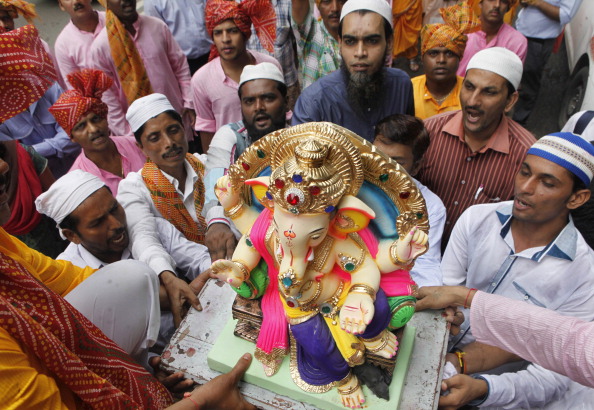
Primarily, yes, Ganesh is a Hindu God – as stated above. However, it’s not uncommon for non-Hindus to have statues of him in their homes. Many people like to have statues of him in their homes for the assurance of divine protection.
There are also plenty of links between Hinduism and Yoga. So, people who practice Yoga will often go out and buy Hindu deities, like Ganesh, for their home.
You will find no reason against owning a Lord Ganesha symbol/statue. If you like what he stands for, then that is reason enough to get him established in your space. Even atheists enjoy having a Ganesha statue. Because it is more than just a religious act- it’s a spiritual one.
What Does Ganesh Look Like?
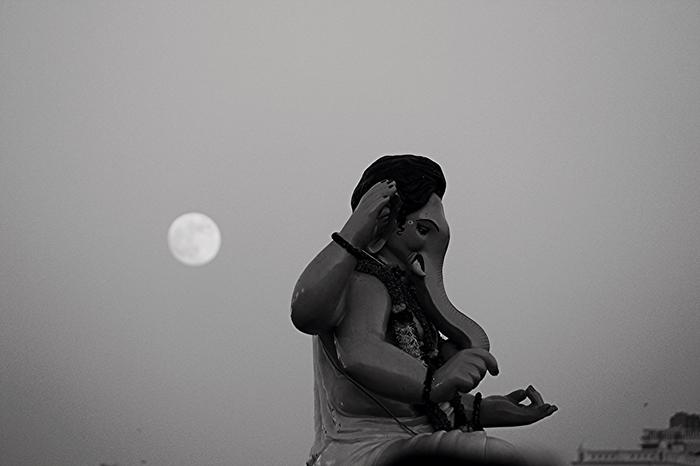
As alluded to earlier, Ganesh has a very unique appearance. His main feature is the elephant head on top of a human-looking body. But, did you know that this head is representative of something? It’s meant to symbolize intellect, while the trunk shows his ability to discriminate between things. In Hindu scriptures, Ganesh uses his trunk to help him carry out a variety of tasks, too.
Along with his iconic elephant head, there are numerous symbols within his appearance. Ganesh has a trident tattooed on his forehead, which is used to symbolize the past, present, and future. It is also a nod to his father, Shiva, who is represented by this trident symbol. He also has a rope that represents the ability to pull worshipers to their highest goals. Ganesh is often depicted with a bowl of sweets in his hand, too. This is a symbol of the sweetness of life and represents self-enjoyment.
Many Ganesh statues will also show him wielding a small axe. This hints at him being the breaker of obstacles. The axe is used to relieve pain & suffering, and to push man towards the path of righteousness. Ganesh is also known to have one broken tusk on his elephant head. Symbolically, this shows his ability to keep what’s good and throw away what’s bad. Another key feature of Ganesh is his large belly. This is also a symbol; His belly is used to digest all of the good and bad things in this world.
These are a few of the key features you will see in the depiction of Lord Ganesh. Some people prefer to purchase statues with as many of these symbols as possible. It’s thought that the more symbols you see, the more protection you get from this God.
What Types Of Lord Ganesh Statues Are There?
Lord Ganesh statues come in a wide variety. You get ones that are quite simple and ones that are more complex and in-depth. It’s common for Hindus to purchase Ganesh statues that are more detailed and have lots of symbolic messages. Plain and simple ones are more popular for people looking to decorate their home.
However, by different features, we don’t just mean the material of the statue. You will also find some that differ because of the posture of Ganesh. Below, we’ve listed a few different types of Ganesh statues that you’re likely to see:
Sitting Ganesh
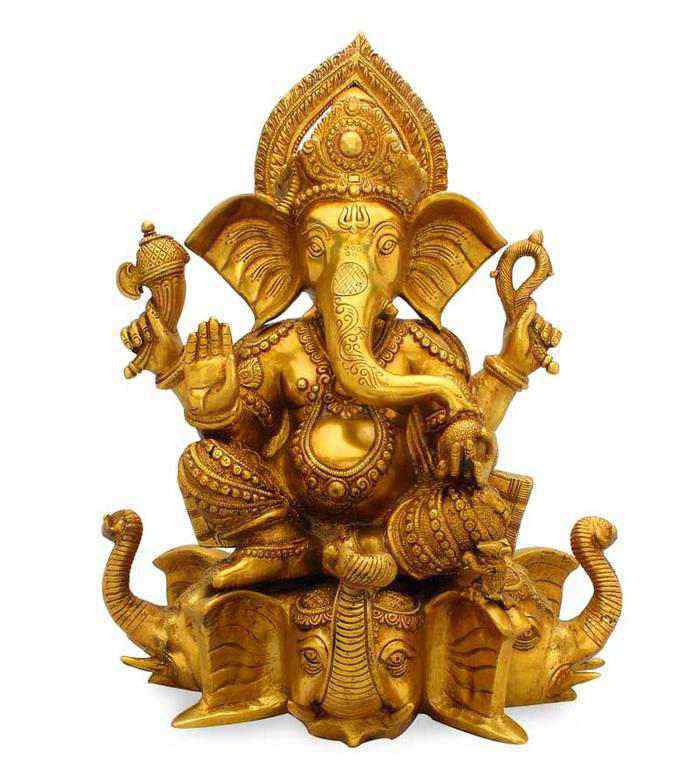
Perhaps the most common type of statue is one depicting Ganesh sitting down. This is likely the one you’ll find when you visit people’s homes. While seated, Ganesh is thought to be meditating, which represents calmness. He is sitting down and keeping watch over you and your family, ensuring everyone is well protected. Now, you know why these statues appear in homes quite frequently.
There are other types of sitting Ganesh statues as well. Some sitting Ganeshes are depicted with crossed legs, while others have one leg on the ground. The change in leg position isn’t a random thing; it holds meaning. Cross-legged symbolizes meditation, as mentioned above. But when one leg is on the ground, it shows he is concerned. It represents Ganesh being concerned for the lives of those who worship him.
Standing Ganesh
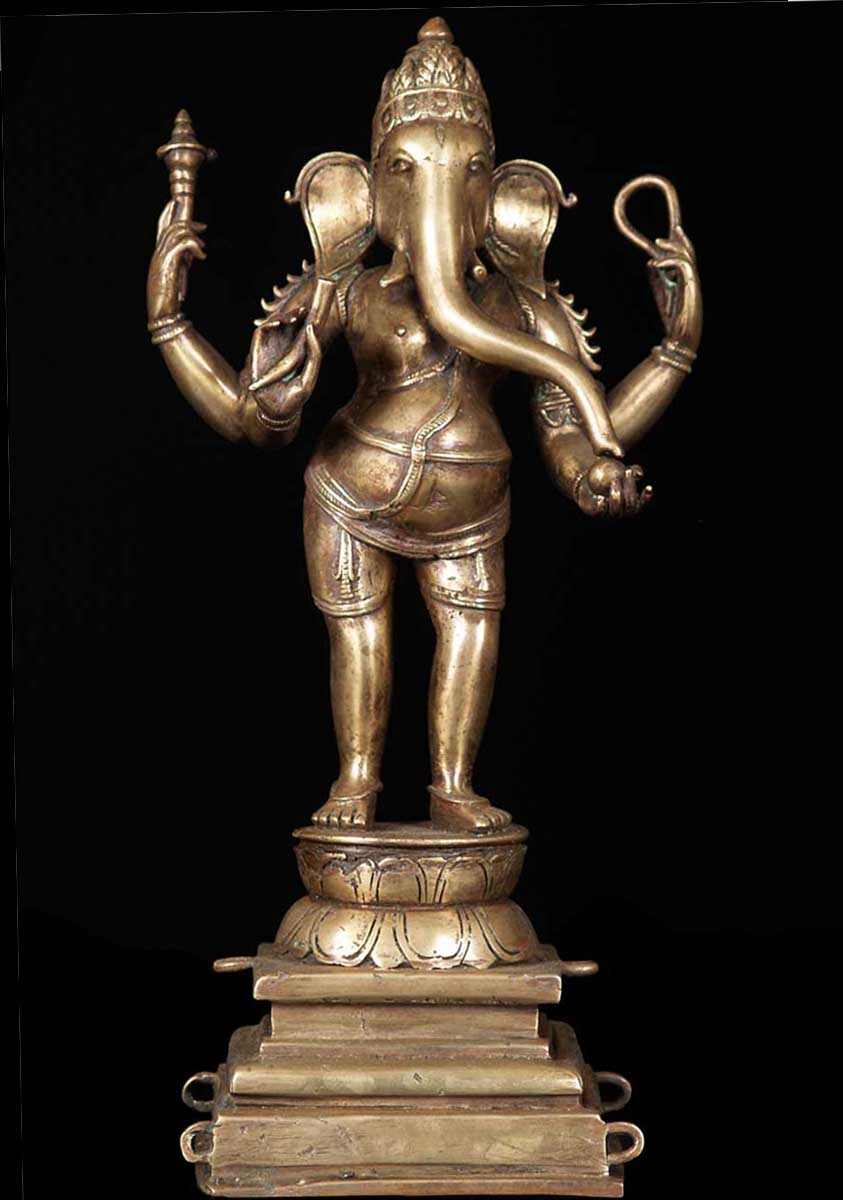
The second most common type of statue is one where Ganesh is standing up. Again, this is another statue that people will have in their home. A standing Ganesh statue is very different from a sitting one – both in appearance and symbolism. You get a true sense of his size when he is standing up and can see the large belly more clearly. When he stands up, it symbolizes power and attitude.
Not surprisingly, there are different types of standing Ganesh too. Some statues show him with more bends in his body than others. Plus, there are some with both legs on the ground, and others where one foot is resting on a mouse. This mouse, Mooshak, is his vehicle or mount. Its purpose is to show Ganesh can “chew” through any problems.
Dancing Ganesh
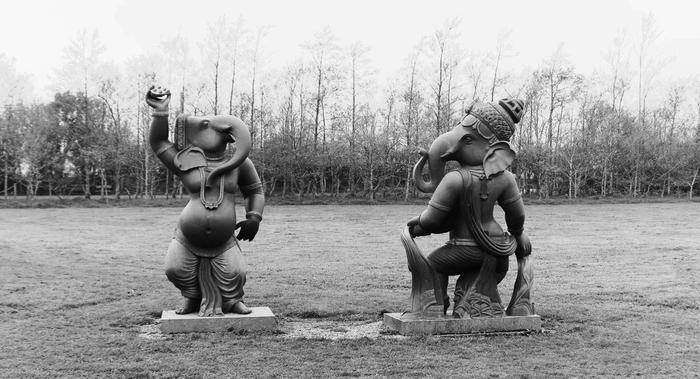
A dancing Ganesh can easily be confused with a standing one. While they are both upright, there are many differences between the two. When Ganesh dances, it is known as the ‘Dance of Destruction’. This is why it is not common to use this statue for worship. However, it is widely used for decoration and gifting.
It’s common for Ganesh to stand on his mouse when dancing. This signifies how strong the mouse is and that no weight can crush it. Through the blessing and power of Ganesh, the mouse too achieves great wisdom and strength. However, the dancing Ganesh statues should be used for gifting and decoration only. If you want to worship, then get a sitting Ganesh statue.
Reclining/Lying Ganesh
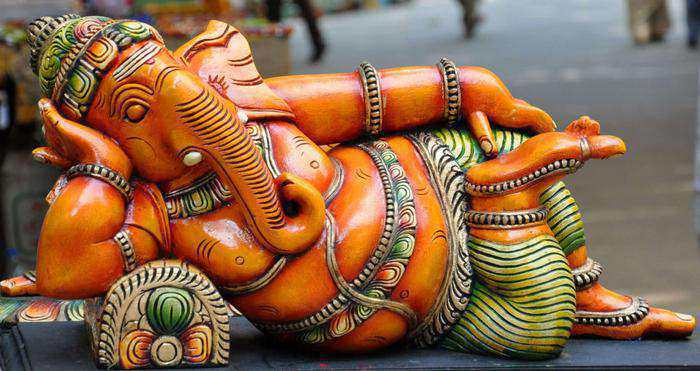
A reclining Ganesh statue is used to signify luxury and comfort. They’re often used by people to decorate rooms in their house. In this depiction, Ganesh is often seen as royalty and dressed in posh clothes.
Again, this is not seen as a statue that people should use for worship. They’re more commonly used for home decor. This is because it’s another creative depiction of Lord Ganesh. Much like dancing, he’s seen doing something creative to add an element of fun to the statue.
Eco-friendly Ganesha
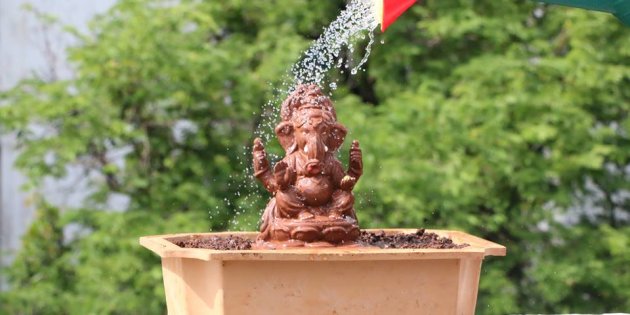
Ganesh Chaturthi celebrations culminate in the immersion of huge Ganesha idols into the sea, rivers, and lakes. The idols are mostly made up of plaster of Paris and do contain toxic chemical that causes considerable harm to marine life. In a bid to reduce environmental damage, many devotees have begun installing Ganpati idols that are both innovative and eco-friendly.
They are handmade with love by farmers and made using 100% biodegradable raw material, which makes them more than just eco-friendly. Each idol comes with a seed embedded within it, which, when put in soil, germinates into a plant. Eco-friendly Ganpati statues are a sustainable way to celebrate. Even if you’re immersing it in the lake, it melts into the water, as it is made primarily with Cow Dung.
You can also gift this biodegradable Ganesh idol to friends and relatives by shopping online. Likewise, you can surprise them with Ganesh Chaturthi gifts that are available online.
How to make a Ganesh statue at home?
Ganesh Chaturthi is an incredible festival celebrated with joy and prosperity. Carving an idol at home can be a fascinating activity for both parents and children. Crafting a biodegradable idol is not only a fun activity for the kids, but it also gives them an idea about environmentally friendly ways.
We have given the step-by-step procedure to prepare lord Ganesh effortlessly with organic colors to make things easy for you.
Step-by-Step Procedure to Prepare DIY Ganesh Idol
Items Required
- Terracotta clay
- Toothpicks
- Acrylic colors
Duration: 1-2 hours
Procedure
- Firstly, arrange all the items in one place, so you don’t have to worry about missing out.
- Split the clay form into multiple chunks and shape it into a round shape.
- Take clay lumps and make a pair of legs, hands, ears, stomach, trunk, and head to resemble the body parts.
- Now fix all the body parts using toothpicks (a maximum of 8 are required) and press gently.
- You can add designs to the crown and allow it to dry for some time.
- Add colors to make it look beautiful and elegant.
Your homemade eco-friendly Ganesh idol is ready to be worshipped
What Do You Need To Know When Selecting A Statue?
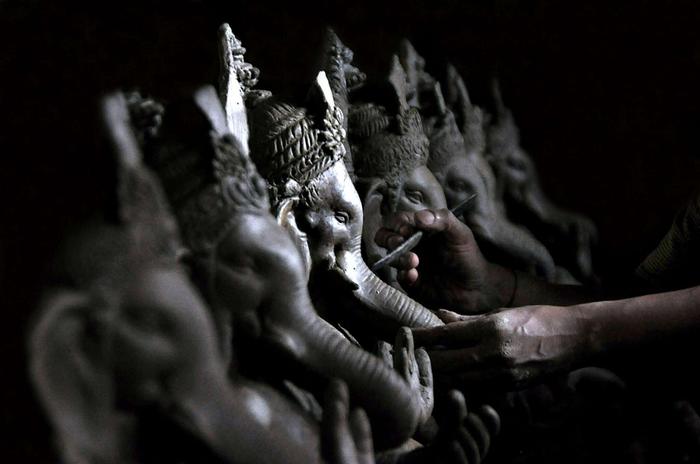
Choosing the right statue can be much harder than you might think. Firstly, you have to think about all of the information that was just presented to you. What posture do you want your Ganesh statue to be in? If you’re using it for worship purposes, then you must choose either sitting or standing. But if you’re buying one as decoration, then you can choose any.
There is also one key thing to look at when picking your statue: the trunk. The placement of his trunk is very important as it has symbolic meaning. If you intend to keep your statue at home, it’s advised that you buy one with the trunk on the left-hand side. This is thought to signify calmness and happiness, making it ideal for your home.
Statues with trunks on the right-hand side are meant to symbolize rituals that must be completed daily. That’s why you find them in temples where the rituals can be carried out properly.
Apart from these, you will also find trunks that face forward. Some consider this to have the highest significance of the three. A statue with a forward-facing trunk shows that Ganesh has reached the peak of his powers. It’s a symbol of enlightenment. You will often see these statues with the trunk up in the air as well. These statues make the perfect gift and can be put in your home or office space.
Where Should You Put Ganesh Statues In The Home?
There are a few rules you should follow when placing a Ganesh statue in your home.
- Firstly, you should never keep one on the floor. It should always be kept at an elevated level so Ganesh can watch over you and your family.
- One of the best places to keep a Ganesh statue is by the front entrance of your home. By doing this, many believe he will help protect your home from evil and bring you good luck. Many people create a place above their front door to place the statue, making him the guardian of their home.
- You can also keep these statues in a cabinet or case with other ornaments and statues. But, if you do this, you can’t have them touching other items. There should be a gap of around one inch between your Ganesh and anything else.
- A popular place to put a Ganesh statue is in your bookcase at home. Lord Ganesh is associated with books and education, so a bookcase or bookshelf is the right place for him as well.
Of course, if you have a dancing or reclining statue, then you can place it wherever you want. These aren’t used for religious purposes, and there are no rules you must follow.
Different places have different Ganesh statues. If you wish to experience various sculptures and offer prayers, head over to the historical places to visit during Ganesh Chaturthi.
Significance of Ganesh Visarjan
After 9 days of worshipping the lord with joy and devotion, it’s time to say goodbye. On the tenth day of Ganesh Chaturthi, statues of the Lord are immersed in the river. Legend says that Ganesha returns to Mount Kailash to join his parents, Lord Shiva and Goddess Parvathi.
But there’s another significance to it, too. It is believed that when he leaves your home, he takes away all the obstacles with him, and they are destroyed with the Visarjan.
How Do Different States in India Celebrate Ganesh Chaturthi?
Ganesh Chaturthi, a vibrant and widely celebrated festival in India, is marked by diverse customs and traditions across the country’s various states. While the central theme of the festival remains the same – honoring Lord Ganesha, the remover of obstacles – the way it is observed varies from region to region.
In Maharashtra, particularly in Mumbai, Ganesh Chaturthi is a grand affair. Elaborate processions with colorful idols of Lord Ganesha, known as “Ganeshotsav,” dominate the scene. The city’s streets come alive with music, dance, and fervent devotion as people carry the idols to immerse them in the Arabian Sea, bidding a temporary farewell to their beloved deity.
In Karnataka, especially in the coastal regions, the festival is celebrated with equal enthusiasm. Clay idols are placed in homes, and families gather for prayers and cultural performances. The immersion ceremony takes place in rivers and lakes, creating a picturesque sight.
In Tamil Nadu, Ganesh Chaturthi is a more private celebration. Families install idols in their homes, conduct pujas (prayers), and offer a variety of sweets to the deity. The festival is known as “Vinayaka Chaturthi” in this state.
In Andhra Pradesh, the festival is marked by vibrant processions and community gatherings. Huge idols of Lord Ganesha are paraded through the streets with much fanfare before being immersed in water bodies.
In Odisha, Ganesh Chaturthi is celebrated with both community and private gatherings. Pandals (temporary stages) are set up in various neighborhoods, where elaborate idols of Lord Ganesha are worshiped. The festival also includes cultural performances, music, and dance, culminating in the immersion of idols in local rivers or lakes.
In Telangana, the festival is celebrated with immense grandeur, especially in Hyderabad. Large pandals are erected across the city, housing beautifully decorated idols of Lord Ganesha. Devotees participate in processions, cultural events, and prayers, with the immersion of idols taking place in Hussain Sagar Lake, marking the end of the festivities. If you want to dress up for the festivities, you can save on festive wear by using Craftsvilla coupons for your Ganesh Chaturthi shopping.
In Madhya Pradesh, Ganesh Chaturthi is celebrated with a blend of community and individual devotion. In cities like Indore and Bhopal, public pandals are adorned with idols, while many households also worship smaller idols. The festival sees a mix of religious rituals, cultural activities, and processions, with the idols being immersed in local water bodies.
In each state, the celebration of Ganesh Chaturthi reflects the unique cultural tapestry and traditions of the region, while collectively expressing reverence for Lord Ganesha’s blessings and the spirit of unity that the festival embodies.
Hopefully, this article has been informative, and you now know a lot more about Ganesh Chaturthi and Lord Ganesh statues and how to use them in your home. Wishing you an auspicious celebration.
Happy Ganesh Chaturthi!

